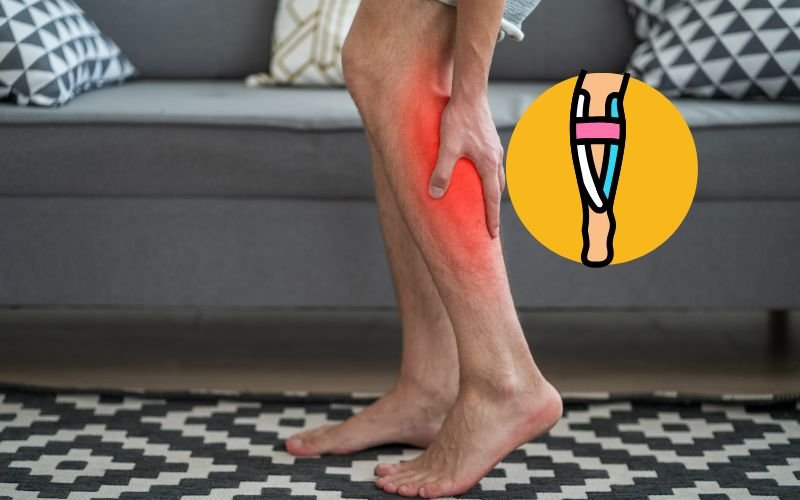The muscles in your calf play a key role in how you stand, walk, and move. Yet, when pain or injury strikes this area many people do not realize the seriousness until it starts affecting daily life. Calf pain can feel like a dull ache or a sudden, sharp pull. The reasons behind it can range from mild strains to serious blood clots. When ignored, even simple calf pain can grow into a long-lasting problem. In this article, a trusted orthopedic specialist in Delhi walks you through what calf pain means, its causes, symptoms, treatment options, and how to recover safely
What Is Calf Injury?
The calf lies at the back of your lower leg. It includes two major muscles—gastrocnemius and soleus—that work together to support your ankle, knee, and foot. A calf muscle injury happens when you stretch or tear one of these muscles or tendons. This kind of injury is common in runners, athletes, and people who make sudden movements. Even those with a desk job may feel calf pain from long hours of sitting without proper leg support
Calf Injury Symptoms to Watch For
Symptoms may appear slowly or suddenly, based on how the injury happened. A person with a calf muscle injury may notice:
- Pain in the lower back leg while walking or standing
- Muscle stiffness
- Sudden sharp pain during activity
- Swelling or bruising in the calf
- Difficulty standing on toes
- Tenderness in one or both legs
These calf injury symptoms must not be ignored, especially if they get worse over time. An accurate diagnosis by a bone doctor in Dwarka or a reliable orthopedic specialist in Delhi is the best way to start your recovery.
Common Calf Pain Causes
Understanding the reason behind your pain helps you avoid it in the future. Let us look at the most common calf pain causes:
1. Muscle Strain or Tear
This is the most common reason for calf pain. Overuse, skipping warm-ups, or sudden movements can stretch the muscle too far and cause a tear.
2. Cramps
Muscle cramps can occur due to dehydration, long workouts, or mineral loss. These can feel like a tight knot in your calf.
3. Blood Clot
A deep vein thrombosis (DVT) is a dangerous cause of calf pain blood clot. This needs urgent medical help. Swelling in one leg, pain that increases with walking, and redness could point to this issue.
4. Nerve Issues
Sometimes, a pinched nerve in the spine can lead to pain that travels down the leg and reaches the calf.
5. Achilles Tendonitis
The Achilles tendon connects your calf muscle to the heel. When inflamed, it can cause pain and tightness near the back of the leg.
Calf Pain on Walking: A Sign to Take Seriously
If you often feel calf pain on walking, it could be more than a sore muscle. It may signal poor blood flow or early signs of vascular issues. Pain that comes and goes with movement can also hint at peripheral artery disease (PAD). You must consult a calf pain treatment in Delhi expert to find the root cause before the pain turns chronic.
Why Calf Pain in Both Legs Is Worth Checking?
While most calf injuries occur in one leg, calf pain both legs may suggest a systemic issue. This can include electrolyte imbalance, medication side effects, or nerve damage. When both calves hurt and the pain lasts beyond a day or two, it is best to speak to a bone doctor in Dwarka or visit a ortho hospital in Delhi that also houses orthopedic care.
Calf Pain Treatment in Delhi: What Are the Options?
When it comes to calf pain treatment in Delhi, several proven solutions are available:
1. Rest and Ice
For mild strains or cramps, rest and ice packs help ease pain and reduce swelling.
2. Compression and Elevation
Using a compression bandage and elevating your leg helps reduce swelling and improve blood flow.
3. Medications
Anti-inflammatory drugs may be advised by your doctor to manage pain and swelling. Do not self-medicate without consulting an expert.
4. Physical Therapy
A trained physiotherapist teaches stretching and strengthening exercises. These improve calf strength and speed up calf injury recovery.
5. Surgical Options
In rare cases like tendon rupture or large muscle tears, surgery may be needed.
What Is Calf Injury Recovery Timeline?
Calf injury recovery depends on the grade of the injury:
- Grade 1 (mild strain): 1 to 2 weeks of rest may be enough.
- Grade 2 (partial tear): 3 to 6 weeks with therapy.
- Grade 3 (complete tear): Several months, sometimes with surgery.
Sticking to your care plan and following post-recovery stretches are key to healing fully.
What is calf injury? It’s more than muscle pain. It’s a signal from your body that something needs care. Calf pain can limit your movement and affect your quality of life. With the right knowledge, early care, and expert help, you can recover and return to normal. Never ignore the signs, and always trust skilled professionals like Dr Mahanta at The Bone Clinic for your healing journey.




